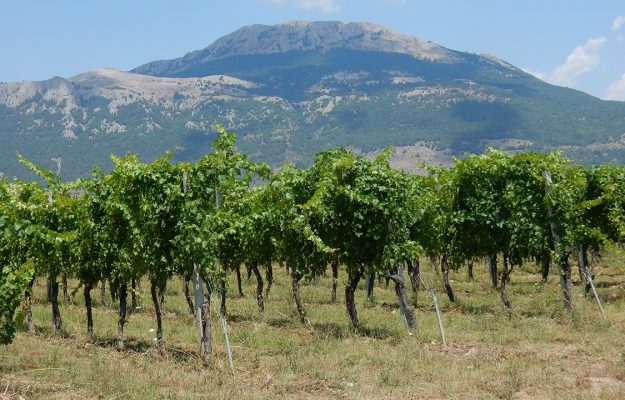What if the history of the domestication of the vine in Italy (as a geographical entity, not as a State/Nation) as we know it today was, to say the least, incomplete and needed to be rewritten in large parts? Professor Stefano Del Lungo, archaeologist and CNR researcher is convinced of this, signing the volume “Among the mountains of Enotria - Ancient shape of the Territory and viticultural landscapes of the Alta Val d’Agri”, the result of two years of research which combines historical genetics with archeology through the biological sciences (the DNA of the varieties), agronomic (environmental qualities and ampelographic characteristics) and Antiquity (the ancient topography of the river valleys, plant biodiversity rendered in terracotta and metal, cellars in the cave, the archival documentation supplied). Starting from grapes and wine, he tells how in the Lucanian inland, when the Greeks arrived, viticulture was already a widespread practice. But also of how the spread of the vine along the peninsula, and then in France, has taken different paths than those we have previously assumed.
The question posed by Professor Stefano Del Lungo challenges historical assumptions: how did the Greeks introduce viticulture to Italy? The research, which follows in the footsteps of the Greeks and then the Romans in their penetration of the Apennine territories in search of the grapes and wines that they then bring back to their motherland, demonstrates that things did not go as we think. Enotria, literally “land of the vine tied to the pole” (oinòtron), with two heads of fruit to better resist the winds, represents that portion of the Apennines - from Cilento to Calabria - where the Greeks are struck by the discovery of a cultivated hinterland, with a landscape distinctly marked by viticulture and thus, according to their culture, “non-barbarian”.
“The commonplace of a Greek civilization that would have introduced the cultivation and civilization of the vine into the Italian peninsula was destroyed in an investigation that goes upstream of the Agri, from its mouth to its source”, says the archaeologist. “The first settlers arrived in the VIII century B.C., mostly from mainland Greece, and settled on the islands and coasts, bringing with them the preconception of a hostile, dangerous, and uncultivated inland, as summarized in the verses of the Odyssey at the time. By reconstructing the culture and mentality that guide the settlements of the settlers with concrete proof and documented evidence, it is clear to see their surprise at being faced with an evolved civilization, the Enotra, an expert producer of a primary good such as wine, as well as precious metals, especially iron, and copper. Through genetics, the classical sources find confirmation in the vine varieties, recently recovered in years of exploration of old vineyards in the Apennine hinterland, and with surprising results”.
“The circulation of these varieties, going up the internal river valleys, is intense in the centuries between the IX and the beginning of the V century B.C. Viticulture is not an afterthought; it is the foundation of a thriving economy, as evidenced by the rich funerary objects. The Pollino massif, located between the fertile Sibaritide and the Sinni valley, becomes one of the preferred areas for Sangiovese, which originated in the Messapian lands near the Doric Taranto before traveling to Sicily and up the Tyrrhenian coast, leaving numerous descendants between the Basento and the Sinni. This in turn is the progenitor of varieties that between the V and IV centuries B.C., thanks to the Lucanians and the Samnites, they will travel the Apennines up to central Italy”, explains Professor Del Lungo.
“The colony of Siris, near Policoro, founded by Ionia, dissociates itself from the closure of the nearby Greek cities and expands inland towards the Tyrrhenian Sea. He calls it Siritide and uses the name Sirino to indicate the important geographical elements (the major river, now Sinni, and the highest mountain, the Sirino), as well as a city strategically located along the internal road between the Ionian and Tyrrhenian coasts (Sirìnos, near Rivello) and the most promising vine variety in those territories (the Sirino or Serino). Close relatives can be found in the surrounding valleys, including the one that will take the name of Aglianico. Between the VI and V centuries B.C., thanks to the Ionian colony of Elea (Velia), in Cilento, it takes the road to Marseilles and with the Greeks, it spreads in the middle Rhone valley. For a long time, it was known as Serine before being renamed Syrah, a more exotic but misleading name. It has nothing to do with Persia, and etymologically, it retains the name’s inheritance in the Sibarite and Samnite forms (Sirica). The Romans will transform it into “Syriac”, however in the documented awareness of a direct relationship with the Campania and Lucanian regions, not with the Near East, as claimed today on the web and beyond”, concludes the archaeologist.
Copyright © 2000/2025
Contatti: info@winenews.it
Seguici anche su Twitter: @WineNewsIt
Seguici anche su Facebook: @winenewsit
Questo articolo è tratto dall'archivio di WineNews - Tutti i diritti riservati - Copyright © 2000/2025








































































































































































































